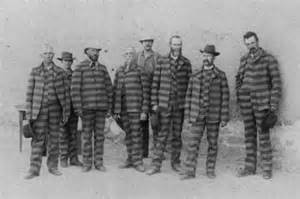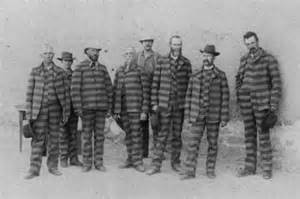Why Prison Uniforms Were Striped and Why They Aren’t Now
 If you’ve seen a prison movie either filmed or set before the 1960’s, than you’ve had a pretty easy time figuring out the players. The guards had blue suits while the prisoners wore baggy, ill-fitting (and frankly unflattering) horizontal stripes. Think George Clooney in Oh Brother Where Art Thou or Bugs Bunny in almost anything and you get the idea.
If you’ve seen a prison movie either filmed or set before the 1960’s, than you’ve had a pretty easy time figuring out the players. The guards had blue suits while the prisoners wore baggy, ill-fitting (and frankly unflattering) horizontal stripes. Think George Clooney in Oh Brother Where Art Thou or Bugs Bunny in almost anything and you get the idea.
They all sported the state-issue striped pajamas.
The uniform of a convict in the penal system is almost considered a classic, and in some places in the US and abroad, the horizontal stripes are still in use. But, while the prison guards’ uniforms have pretty much remained the same since inception, the prisoners’ uniforms have changed over time.
Why exactly did the uniforms change, and more importantly, why were they such an unflattering horizontal striped abomination in the first place?
The answer lies, in part, with the Quakers.
In the 18th century, jails in America were used less for housing criminals and more for confining them until after their trials and sentencing. Most were cells where the accused were housed in solitary confinement awaiting a hearing. They were fed, slept, and existed in solitary, but since most punishments were either death, banishment, or public torture, such as a flogging, there was little back-log and turn-over was quick.
Things changed a bit in the 19th century, when flogging went out of fashion and the state backed off the death penalty as a “wide spread” criminal deterrent. Criminals were now being sentenced to incarceration rather than torture, and with this “forward thinking” some changes needed to be made.
Enter the Quaker ideal.
In New York, the gem of the penal crown was the Auburn Prison, and with it came change. Before they opened their doors (and quickly closed them behind their guests) solitary confinement was still the norm, and it led to rioting and suicides in the prisons. Outside the prison gates, the public cried for change.
The Auburn System stressed the rehabilitation of the criminal and at the same time used the criminal work-force to reduce the prison’s burden on the state. And all in complete silence!
The Quaker ideals of the prison were that the convicts worked in complete silence during the day. They spent their days in intense physical labor, chained to the next man, and were not allowed to speak or even make eye contact with another person.
Punishment was harsh and brutal and the inmates were forced to sleep in solitary confinement every night. When the prisoners marched on the field, they did so in chains and in lock-step, meaning that they marched single file, looking ahead, with their left hand on the shoulder of the prisoner in front of them in silence.
And the uniform of the day, every day, was the prison stripes.
The most obvious function of the uniforms was that they were different than every other set of clothes anywhere. One glance at a prison work yard could tell you who was a guard and who was an inmate. Also if you were to see someone walking through a field or forest dressed in the stripes, all sorts of alarms and flags went off. There was clearly no mistaking this particular suit.
But another, lesser known function of the suit was to serve as a reminder to the criminals of where they were, what they had done, and what society thought of them. The stripes on the uniform were representations of the metal bars that imprisoned them. Wherever they looked, wherever they went, their uniforms served to remind the inmate that he had only as much freedom as the state allowed him, and that was precious little.
By the end of the 1800’s, society in general called for more rights in their prisons. The list of grievances included hard labor, solitary confinement, and the treatment of the prisoners. One of the things that also fell by the wayside was the striped uniforms.
After the prison reforms of the 1900’s, prison uniforms went to a solid grey uniform for the most part, with jean shirts and pants used in some cases. As times changed and a need to keep prison convict’s looks different than the public at large, scrub-like uniforms replaced the jean fabric; but again, that proved problematic.
In the late 1900’s, nurses, doctors, and many others went out in daily life wearing similar scrubs. This prompted even further change.
Today most criminals wear an orange jumpsuit that is almost as unflattering as the classic horizontal stripes. Their uniforms are utilitarian in nature and serve the same purpose as previous ones. At a glance you can tell who is who in any given prison yard, and the sight of someone running through a field in an orange jumpsuit is sure to raise a few flags.
Today’s prisons face a number of challenges, chief among them overcrowding, poor conditions and violence. These are issues for another story, and possibly another blog. And while the situation seems quite dire, there is one thing in which prisoners can take small solace.
At least the uniforms could be worse.
